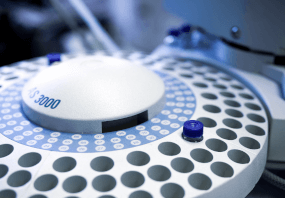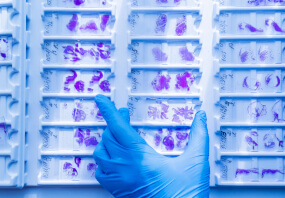General description
Cartilage acidic protein 1 (UniProt: Q8R555; also known as 68 kDa chondrocyte-expressed protein, CEP-68, ASPIC, Protein CRTAC1-B, Lateral olfactory tract usher substance, LOTUS) is encoded by the Crtac1 (also known as Aspic1, Cep68) gene (Gene ID: 72832) in murine species. LOTUS is synthesized with a signal peptide (aa 1-28), which is subsequently cleaved off to generate the mature form (aa 29-646). It is a membrane-bound and/or secreted protein that serves as an endogenous Nogo receptor-1 (NgR1) antagonist. It is shown to contribute to the formation of the lateral olfactory tract (LOT) axonal bundle. Endogenous Nogo-A signaling through NgR1 is shown to induce axonal branching. Developmental up-regulation of Nogo-A promotes collateral formation of the LOT during the late development period. It has been reported that axon growth inhibitors, which include Nogo proteins, myelin-associated glycoprotein (MAG), oligodendrocyte myelin glycoprotein (OMgp), and B lymphocyte stimulator (BLyS), bind to NgR1 and restrict functional recovery after damage to the adult central nervous system. LOTUS blocks the binding of these ligands to NgR1 and suppresses growth cone collapse. LOTUS knockout mice show significantly increased collateral branches of axons in the LOT. On the other hand, this branching is diminished in NgR1 knockout mice. A simultaneous loss of LOTUS and NgR1 is reported to rescue the abnormal increase in axonal branches. (Ref.: Iketani, M., et al. (2016). Sci. Rep. 6; 39586; Kurihara, Y., et al. (2014). Mol. Cell. Neurosci. 61; 211-218).
Specificity
Clone H24G11 is a hamster monoclonal antibody that detects murine cartilage acidic protein 1B (LOTUS).
Immunogen
Homogenate of protein extract from developing lateral olfactory tract and the surrounding tissues of mouse.
Application
Quality Control Testing
Evaluated by Western Blotting in Mouse E14 brain tissue lysates.
Western Blotting Analysis: A 1:500 dilution of this antibody detected LOTUS in Mouse E14 brain tissue lysates.
Tested Applications
Immunocytochemistry Analysis: A representative lot detected LOTUS in Immunocytochemistry applications (Kurihara, Y., et al. (2014). Mol Cell Neurosci. 61:211-8; Sato, Y., et al. (2011). Science. 333(6043):769-73).
Immunohistochemistry Applications: A 1:50 dilutions from a representative lot detected LOTUS in E14 embryonic mouse tissue sections.
Western Blotting Analysis: A representative lot detected LOTUS in Western Blotting applications (Iketani, M., et al. (2016). Sci Rep. 6:39586).
Immunohistochemistry Applications: A representative lot detected LOTUS in Immunohistochemistry applications ( Sato, Y., et al. (2011). Science. 333(6043):769-73; Iketani, M., et al. (2016). Sci Rep. 6:39586).
Note: Actual optimal working dilutions must be determined by end user as specimens, and experimental conditions may vary with the end user
Anti-LOTUS, clone H24G11, Cat. No. MABN2614, is a hamster monoclonal antibody that detects Cartilage acidic protein 1 (LOTUS) and is tested for use in Immunocytochemistry, Immunohistochemistry, and Western Blotting.
Physical form
Purified hamster monoclonal antibody IgG in buffer containing 0.1 M Tris-Glycine (pH 7.4), 150 mM NaCl with 0.05% sodium azide.
Storage and Stability
Recommend storage at +2°C to +8°C. For long term storage antibodies can be kept at -20°C. Avoid repeated freeze-thaws.
Other Notes
Concentration: Please refer to the Certificate of Analysis for the lot-specific concentration.
Disclaimer
Unless otherwise stated in our catalog or other company documentation accompanying the product(s), our products are intended for research use only and are not to be used for any other purpose, which includes but is not limited to, unauthorized commercial uses, in vitro diagnostic uses, ex vivo or in vivo therapeutic uses or any type of consumption or application to humans or animals.
- UPC:
- 51162012
- Condition:
- New
- Availability:
- 3-5 Days
- Weight:
- 1.00 Ounces
- HazmatClass:
- No
- MPN:
- MABN2614-100UL












